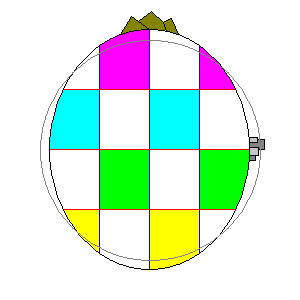Tides and Tidal Forces
Steven Dutch, Professor Emeritus, Natural and Applied Sciences, Universityof Wisconsin - Green Bay
Tides
Most everyone has heard that tides are caused by the Moon, but tides and the forces that cause them are of enormous importance in astronomy. Tides can lock planets' rotations and change the orbits of planets. They can break objects apart and heat them. On a large scale they can tear galaxies apart.
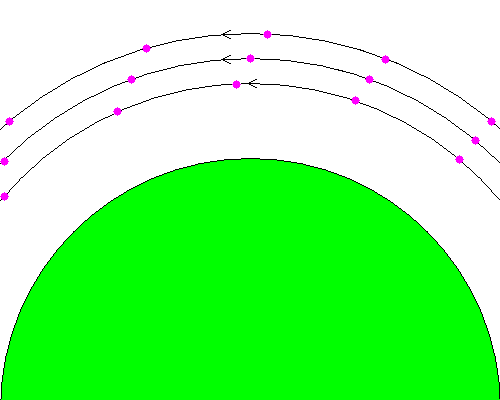
Let's begin with something that seems to have nothing at all to do with tides. Look at three satellites all in slightly different orbits. They start off in a straight line on the right, but since the innermost satellite is moving faster, and the outermost is moving slower, they get farther and farther apart as they move.
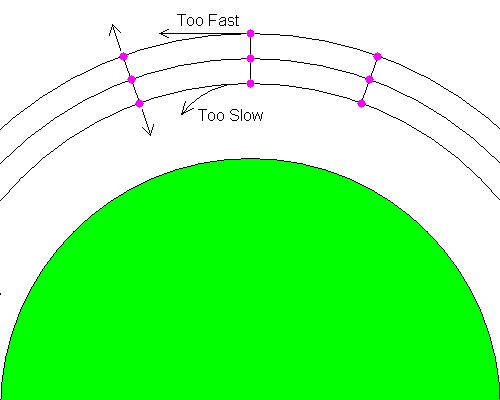
Now let's look at three satellites all in a line, but now they're joined by a tether (tethered satellites have been proposed for various purposes like sampling the upper atmosphere at elevations too high for aircraft and too low for normal spacecraft. The idea is to tether them to a satellite in normal orbit, like the Space Shuttle.) Left to themselves, the satellites would travel at different speeds, but the tether prevents that. The lower satellite is traveling too slowly to remain in orbit at its present altitude, and falls inward. The outer satellite is travelling too fast for its altitude and flies outward (middle diagram). The end result is that the tether is under tension (left diagram).
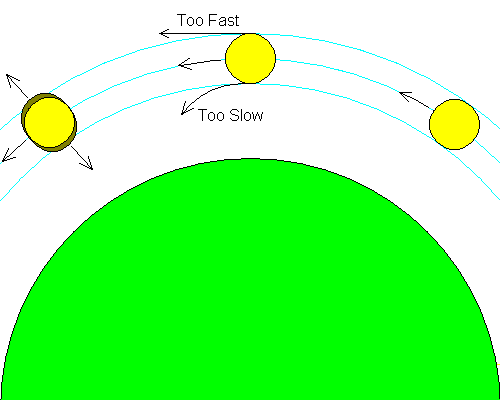
Now let's replace the tethered satellites with a large moon. We still have the problem that objects on the outside are moving too fast for their altitude and objects on the inside are moving too slowly. The far side of the moon tries to fly away and the near side tries to fall inward. Again the moon experiences tension, and it is actually pulled out of shape into an oval. Note that there is a bulge on the near side, which we expect because of the gravity of the larger planet, but also a bulge on the far side, which we don't expect. You can think of the far side bulge as being caused by "centrifugal force."
This tensional force is called a tidal force. Tidal forces are basically due to the gravity of one body pulling on the near side of another body more strongly than the far side. If the moon is close enough to its parent body, the tension can actually be powerful enough to rip the moon apart.
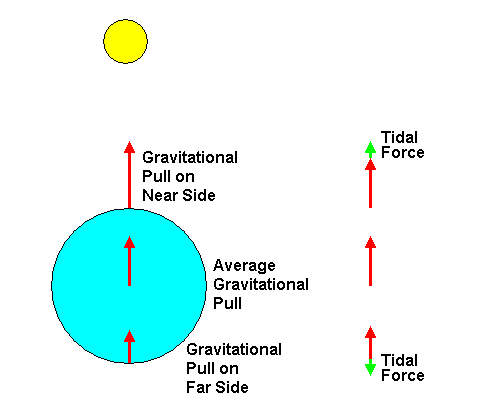
Compared to the average gravitational attraction of the moon toward its parent planet, there is a greater force on the near side and less on the far side. The difference between the actual force and the average force is the tidal force. Note that it points toward the moon on the near side and away from it on the far side.
Notice a bit of a paradox here? A slow moving satellite falls inward, but the closer a satellite is to a planet the faster it moves. A fast moving satellite flies into a higher orbit, where it ends up moving slower. It may seem a paradox, but that's how it works. When astronauts want to rendezvous with, say, the Space Station, to slow down, they step on the gas and to speed up they hit the brakes.
Tidal Forces and Distance
In the last diagram above, the moon has opposing tidal bulges because the planet's gravity pulls more strongly on the near side than the far side. Gravity drops off inversely with the square of distance, but the tidal forces on the moon are due to the difference in gravity between the opposing sides, and that's a lot less than the gravitational force itself. Also, the farther away the moon is, the tinier the difference is between the near and far sides. Tidal forces decrease inversely proportional to the cube of the distance.
To see how important this effect can be, the Sun is about 27 million times the mass of the earth's Moon. But the Sun is about 400 times farther away. The cube of 400 is 64 million. So the Sun's tidal effect on Earth is 27 million divided by 64 million, or about half that of the Moon.
Tides and Rotation
| Here's a planet with a really big tidal bulge. The body causing the tide is somewhere off the top or bottom of the diagram (it doesn't matter which). Watch as the planet rotates. Note that the red and blue lines alternately lengthen and shorten. Also the colored boxes change shape. They lengthen and flatten, and also shear out of shape. Deforming the interior of a planet that way takes energy. Near the surface the rocks can deform elastically, that is, they return to their original shape. Deep in the interior, the rocks are ductile, that is, they flow. |
It takes energy to deform rocks, but when an elastic material snaps back, the stored energy is released. But no material is purely elastic. Drop a rubber ball, and each bounce is lower than the last because some of the ball's energy is absorbed. Drop a ball of modeling clay and it simply flattens when it hits (viscous behavior) and all its energy is absorbed.
When a planet with a tidal bulge rotates, the deformation of its interior absorbs energy and quickly slows the planet's rotation. The earth has slowed the Moon's rotation so that it always shows the same face to the earth, as do almost all the satellites of other planets as well. The Moon has slowed the earth's rotation as well, but since the earth is 81 times as massive as the Moon, the moon's effect on earth has been much less than the earth's effect on the Moon.
We used to think that the Sun's tidal force had locked Mercury's rotation so it always keeps the same face to the Sun. Then in 1965, astronomers discovered evidence that Mercury actually rotates. Nevertheless, Mercury is still locked to the Sun. Mercury has a very eccentric orbit and at aphelion it is 50% farther from the Sun than at perihelion. That means that the Sun's tidal force is 3.5 times greater at perihelion. At perihelion, Mercury sweeps through a bit more than 6 degrees per day and Mercury's rotation is locked to the Sun at perihelion. That means Mercury rotates once every 57 days, or three times for every two orbits about the Sun.
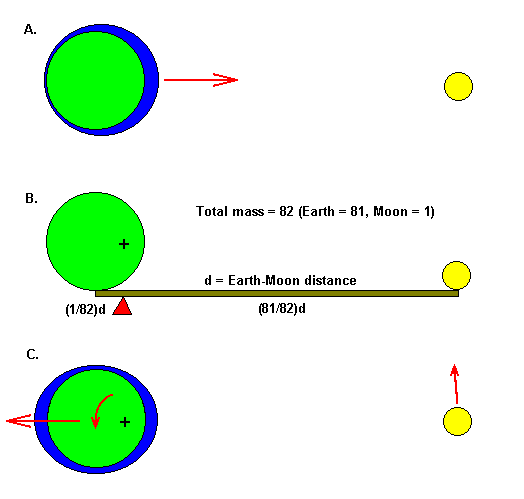
Although we say "the moon goes around the earth," strictly speaking that's not totally true. Both the earth and the moon go around their center of mass. The center of mass is the imaginary point where the earth and the moon together would balance if we connected them somehow and balanced them on a pivot (B above). The center of mass is actually about 1500 kilometers inside the earth.
Just like the moon in the illustrations above, the earth has two opposing tidal bulges. We can say that the moon's gravity pulls on the oceans, so the near-side bulge is easy to understand. But once a month the earth revolves around its center of mass, and the "centrifugal force" throws up a bulge on the far side of the earth, too.
Both Moon and Sun Cause Tides
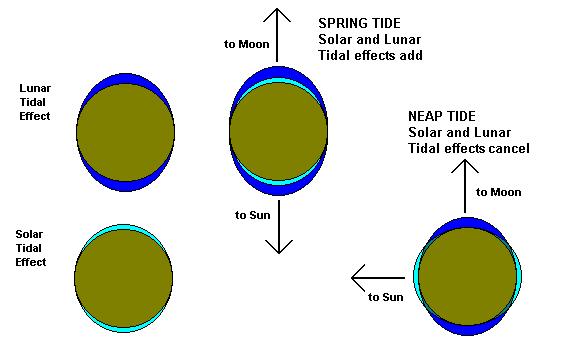
As noted above, the Sun's tidal effect is only about half that of the Moon. Nevertheless, it is still significant. We would have noticeable tides even if there were no Moon. But tides vary over the course of a month as the solar and lunar tides interact.
- Spring Tides
- New or Full Moon
- Sun and Moon Pulling in Parallel Directions
- Lunar and Solar Tides Add Up
- Unusually Large Tidal Range
- Neap Tides
- First or Last Quarter
- Sun and Moon Pulling At Right Angles
- Lunar and Solar Tides Partially Cancel out.
- Unusually Small Tidal Range
Tides Affect Earth's Rotation
There is a small tide in the solid earth, called an earth tide, about a foot (30 cm) high. The earth tide is a fairly simple bulge in the sold earth. Ocean tides are much more complex.
Tides in the oceans cannot move freely because of the continents. They actually flow in a complex manner as shown below. Most often they circulate around nodes, very much the way a wave rotates around a cup as you oscillate it. In narrow, parallel-sided bodies of water the tides move as waves, for example in the South Atlantic. The map below shows the position of high tide crests at three-hour intervals. What this means is that if you go to the beach when the Moon is overhead, you will probably not experience high tide.
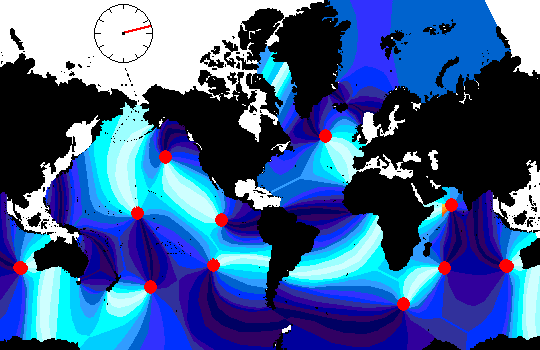
The animation above shows how tides move in the real oceans. In oceans with parallel coasts, like the South Atlantic, or between Antarctica and Australia, the tides move like broad waves. Elsewhere they revolve around points called nodes like spokes of a wheel.
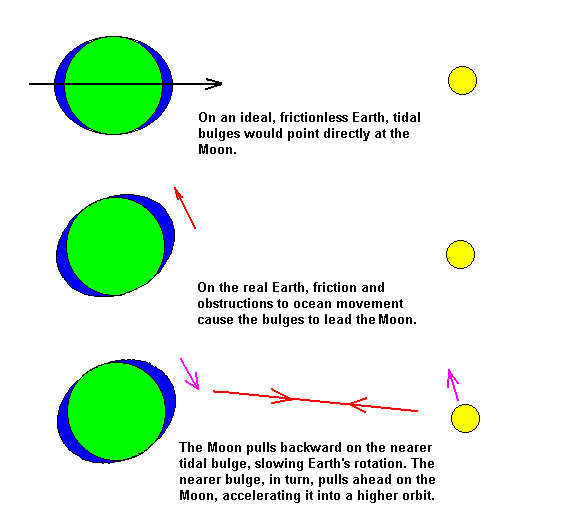
- Rotation and Friction Causes Tides to Lead Moon
- Bulge Pulls Moon, Throws into Larger Orbit
- Friction Slows Earth
- Precambrian (900 m.y.): Year = 500 Days, Day = 18 Hr., Month = 23.4 Days
- Cambrian (500 m.y.): Year = 400 Days, Day = 22 Hr.
Retrograde Satellites
The Moon and most satellites in the Solar System are prograde. They move in the same direction their planets are rotating. What would happen if a moon moved opposite its planet's rotation?
There would still be tidal bulges and friction slowing the planet's rotation, but now the planet's rotation carries the tidal bulges in the opposite direction from the satellite's motion. The bulge pulls backward on the satellite, slowing it down. So the satellite will spiral inward. Eventually it may get close enough to its planet to break up from the tidal stresses. The only major moon in the Solar System in a retrograde orbit is Neptune's large moon Triton, which is predicted to spiral into Neptune in several billion years.
Something similar happens if a satellite moves faster than its planet rotates. The moon constantly leads its own tidal bulge, so the bulge pulls backward on the satellite, causing it to slow down and spiral inward. The only satellites in the Solar System in this category now are tiny inner satellites of Mars, Jupiter, Uranus and Neptune, and their tidal effects are so tiny as to be negligible. But this does have implications for the remote future history of the Earth-Moon system.
Long Term Fate of the Earth-Moon System
The Moon is slowing the earth's rotation by about 2 milliseconds per day per century; that is, since 1900 the day has lengthened by 2 milliseconds. From laser range-finding experiments, the Moon is receding from the Earth at about 4 meters per century. After several billion years, the earth's rotation would have slowed down, and the Moon's motion would also have slowed down because of its increased distance from the earth, so that the earth always kept one face toward the Moon. By this time, the Moon would be about 50% farther away than it is now and the day and month would be about 6 weeks long by our reckoning. We can't predict exactly because we can't predict the future configuration of oceans and continents.
But it doesn't end there. We still have an appreciable solar tide, and it would continue to slow the earth's rotation. Now the earth would be rotating slower than the Moon's motion, and its tidal bulges would trail the Moon, slowing it down and causing it to spiral inward.
We will probably never get to this end point. In a couple of billion years the steady brightening of the Sun will cause the oceans to boil away, eliminating the major cause of tidal deceleration. A couple of billion years after that the Sun will become a red giant star and will very likely engulf the earth.
Return to Professor Dutch's Home Page
Return to Environmental Science/physics 141: Astronomy
Created 07 July 2008, Last Update 17 January 2020
